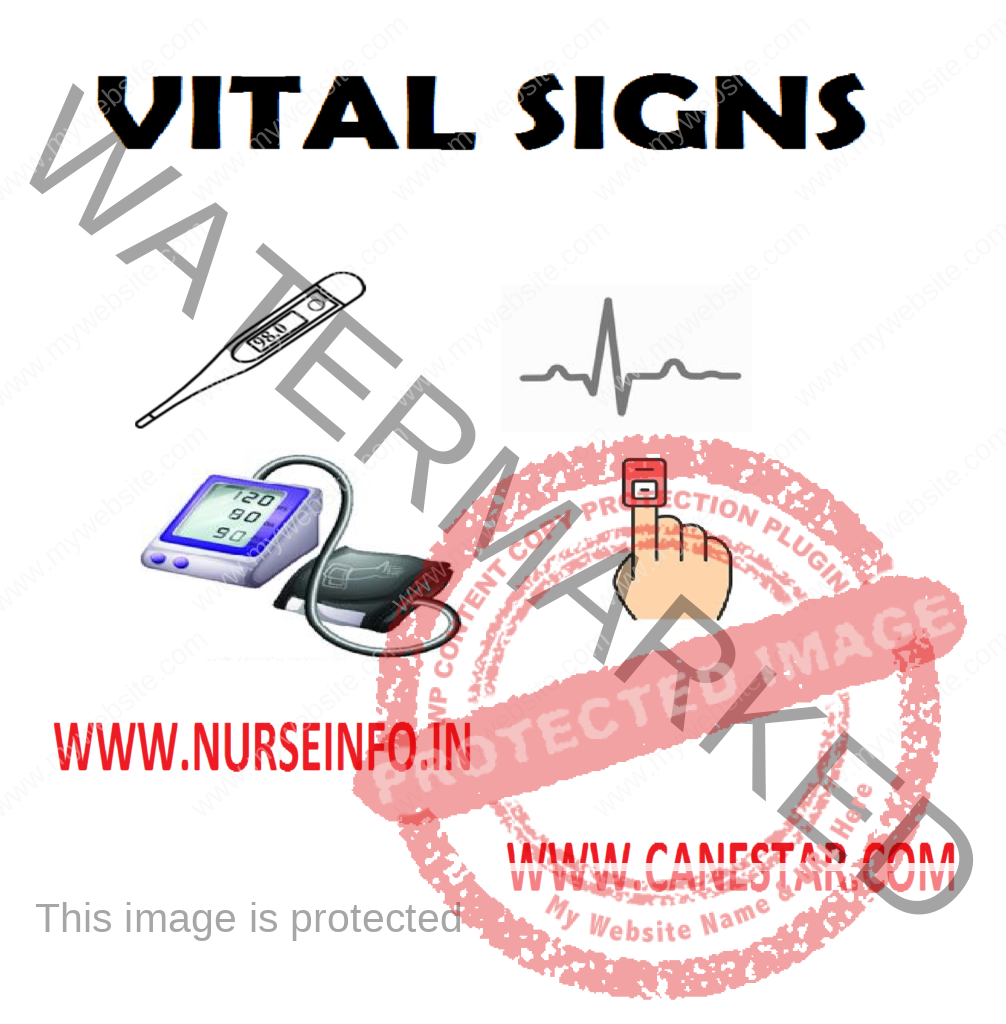UPDATED 2024

VITAL SIGNS
The vital sign or cardinal signs are body temperature, pulse rate, respiration and blood pressure. These signs should be looked at in total, to monitor the vital functions of the body. The signs reflect changes in functions that otherwise it might not be observed. Temperature, pulse, respiration, blood pressure (BP) and oxygen saturation are measurements that indicate a person’s hemodynamic status. These are the five vital signs most frequently obtained by healthcare practitioners.

Vital signs are measurements that provide essential information about the physiological functions of the body. These measurements are crucial indicators of a person’s overall health and help healthcare professionals assess and monitor various bodily functions. The four primary vital signs are:
- Body Temperature:
- Normal Range: Typically around 98.6°F (37°C) when measured orally.
- Methods of Measurement: Oral, rectal, tympanic (ear), axillary (underarm), or temporal artery.
- Heart Rate (Pulse):
- Normal Range: Resting heart rate varies but is generally between 60 and 100 beats per minute (bpm) for adults.
- Methods of Measurement: Palpating the pulse at various locations (e.g., radial artery on the wrist, carotid artery in the neck) or using electronic monitoring devices.
- Respiratory Rate:
- Normal Range: Adults typically breathe 12 to 20 times per minute.
- Methods of Measurement: Observing chest movements or counting breaths per minute.
- Blood Pressure:
- Normal Range: The normal range is around 120/80 mm Hg, with variations based on factors such as age, gender, and health condition.
- Systolic Pressure (the higher number): Represents the pressure in the arteries when the heart contracts.
- Diastolic Pressure (the lower number): Represents the pressure in the arteries when the heart is at rest between beats.
- Methods of Measurement: Using a blood pressure cuff and a sphygmomanometer or an automated blood pressure monitor.
- Pain Assessment: Though not a traditional vital sign, pain assessment is often considered alongside vital signs for a comprehensive understanding of a patient’s well-being.
- Oxygen Saturation (SpO2): Measures the percentage of oxygen in the blood. Normal values are typically between 95% and 100%.
- Capnography: Monitors the concentration of carbon dioxide in exhaled breath, providing information about respiratory status.
DEFINITION

- Vital signs are the measurements
provide data can be used to determine the patient’s usual state of health - Vital signs, or signs of life,
indicate the following objective measures for a person; temperature,
respiratory rate, heart beat (pulse), and blood pressure. When these values are
not zero, they indicate that a person is alive. All of these vital signs can be
observed, measured, and monitored. This will enable the assessment of the level
at which an individual is functioning. Normal ranges of measurements of vital
signs change with age and medical condition
PURPOSE
The purpose
of recording vital signs is to establish a baseline on admission to a hospital,
clinic, professional office, or other encounter with a healthcare provider.
Vital signs may be recorded by a nurse, physician, physician’s assistant, or
other healthcare professional. The healthcare professional has the
responsibility of interpreting data and identifying any abnormalities from a
person’s normal state, and of establishing if current treatment or medications
are having the desired effect
Abnormalities
of the heart are diagnosed by analyzing the heartbeat (or pulse) and blood
pressure. The rate, rhythm and regularity of the beat are assessed, as well as
the strength and tension of the beat, against the arterial wall.
Vital signs
are usually recorded from once hourly to four times hourly, as required by a
person’s condition
The vital
signs are recorded and compared with normal ranges for a person’s age and
medical condition. Based on these results, a decision is made regarding further
actions to be taken.
All persons
should be made comfortable and reassured that recording vital signs in normal
part of health checks, and that it is necessary to ensure that the state of
their health is being monitored correctly. Any abnormalities in vital signs
should be reported to the healthcare professional in charge of care
TIMINGS OF TAKING VITAL SIGNS
- On patient’s admission to a health
care facility - In hospital, on routine schedule
according to physician’s order or hospital policy - During patient’s visit to clinic or
physician’s office - Before and after any surgical
procedure - Before and after any invasive diagnostic
procedure - Before and after administration of
medication that affect cardiovascular, respiratory and temperature control
function - When the patient’s general physical
changes, e.g. loss of consciousness or increase in intensity of pain - Before and after nursing
interventions influencing any one of the vital signs, e.g. before ambulating a
patient previously on bed rest or before patient performs range of motion
exercises - Whenever patient reports to nurse any
non-specific symptoms of physical distress, e.g. “feeling funny or different”
PRINCIPLES OF VITAL SIGNS
- Vital signs are governed by vital
organs and often reveal even the slightest deviation from the normal body
functions - The changes in the condition of the
patient improvement or regression may be detected by the observation of these
signs - Significant variations in these
findings may indicate problems regarding to insufficient consumption - Through vital signs, specific
information may be obtained that will help in the diagnosis, treatment, medications
and nursing care - Patients emotional state may also
cause a significant variation in these
symptoms
METHODS OF MEASUREMENT
- Inspection: inspection means
observing with the eye and is associated with light and seeing - Percussion: percussion is tapping an
area to elicit sounds - Auscultation: auscultation is
listening to sounds within the body with a stethoscope - Palpation: palpation is the art of
feeling with the hand
VITAL SIGNS AND NORMAL VALUES
- Temperature 98.6 degree F or 37
degree Celcius in adults - Pulse 72 beats/minute in adults
- Respiration 16 breaths/minute in
adults - Blood pressure 120/80 mm Hg in adults
GUIDELINES FOR TAKING VITAL SIGNS
- The primary nurse caring for the client is the best one to take vital signs, interpret their significance, and make decisions about care
- Equipment used to measure vital signs must be appropriate and work properly to ensure accurate finding
- Knowing the normal range for all vital signs helps the nurse detect abnormalities
- A client’s normal range may differ from the standard range for that age or physical state. Normal values for a client serve as a baseline for comparing in condition over time
- Know the client’s medical history and therapies or medication, for vital sign changes
- Control or minimize environmental factors that may affect vital signs. Measuring a pulse after client experiences an emotional upset, many yield values that are not clear indicators of the client’s current status
- An organized, systematic approach when taking vital signs ensures accuracy of findings

NURSING PROCEDURES LIST CLICK HERE
NURSING IMPORTANT QUESTIONS – CLICK HERE
Discover more from Bibliobazar Digi Books
Subscribe to get the latest posts sent to your email.



